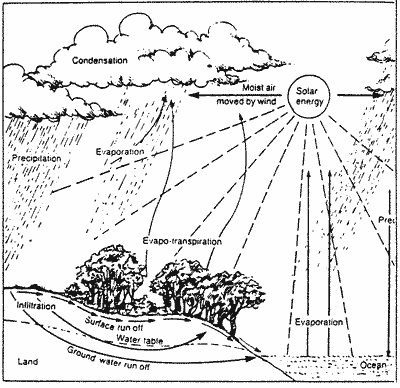
WATER AND SOIL
 | ||
 |
More than 75% of the Earth's surface is covered by water. 97% of this is saltwater in the oceans, 2% is locked up in the ice caps, less than 1% is groundwater (both salt and potable), and the small remaining fraction is in rivers, lakes, and the atmosphere. So little water is readily available and suitable for drinking that a rapidly increasing human population has turned it into a precious commodity. This water is continually on the move and is recycled in and out of the atmosphere through the WATER CYCLE. The water cycle Nature conserves water in the biosphere in many ways - • In rivers, lakes, and ice; • In forests, and all other forms of life; • In the atmosphere (clouds). Where populations locally place disproportionate demands on the natural water balance, wise management is required, and efficient water conservation strategies are necessary. This is particularly so in Townsville because of the climate. The city is in a "rain shadow" and has a tropical drylands (wet/dry) climate. "Water Wise Strategies" Strategies include 
GROWING TREES AND GARDENS: • they store water, humidify and clean the air and provide food; • they provide shade and act as windbreaks (thus reducing evaporation); • they diffuse rain and enable it to soak into the ground (thus reducing evaporation). Avoid high water demand plants unless you have access to recycled water.  REUSING "WASTE" WATER:  REDUCING CONSUMPTION: • an irrigation system saves water and time (drippers less wasteful); • water in the cool of the evening (less evaporation); • build circular gardens to suit the reach of a single central sprinkler; • watering too often - one good soaking is more water efficient; • use plenty of mulch and cover bare patches (conserves soil moisture); • keep plumbing well maintained (drip free); • use water-saving devices like timers, dual flush toilets, and reduced-flow shower roses.  IMPROVING WATER RETENTION • use pervious paving and driveways to allow water to soak into the subsoil. • in rural areas use contour ploughing to trap water and allow more of it to soak in before runoff. • look at the local drainage pattern and try to minimise runoff from your yard e.g. by building up mulch and planting trees and directing excess rain water to the garden wherever possible. What Can You Do? • be careful buying non-native plants; • encourage your local nursery to stop selling invasive introduced plants; • don't dump garden waste in bushland, mangrove areas or saltpans. What looks like wasteland to you is vital habitat to our plants and animals; • learn which plants are weeds; • eradicate invasive weeds from your garden; • join a Landcare Group and take part in a united effort in the control and eradication of environmental weeds in your local bushland area. Or, you could enquire into forming your own local neighbourhood group. |  |
DATE: March 1997
* * * * * * * * * * * * *
